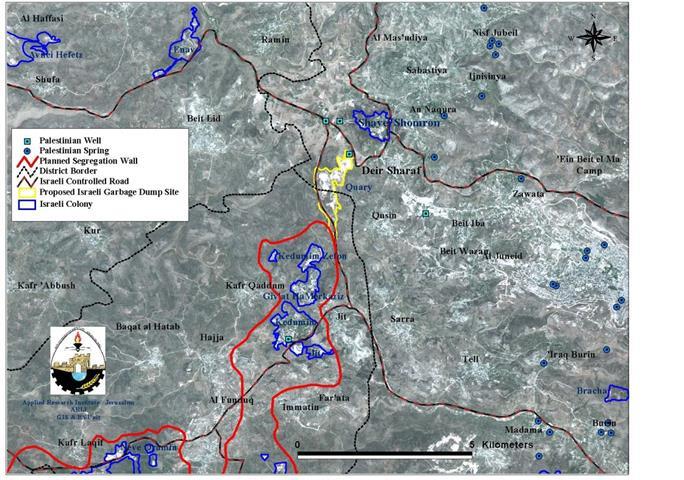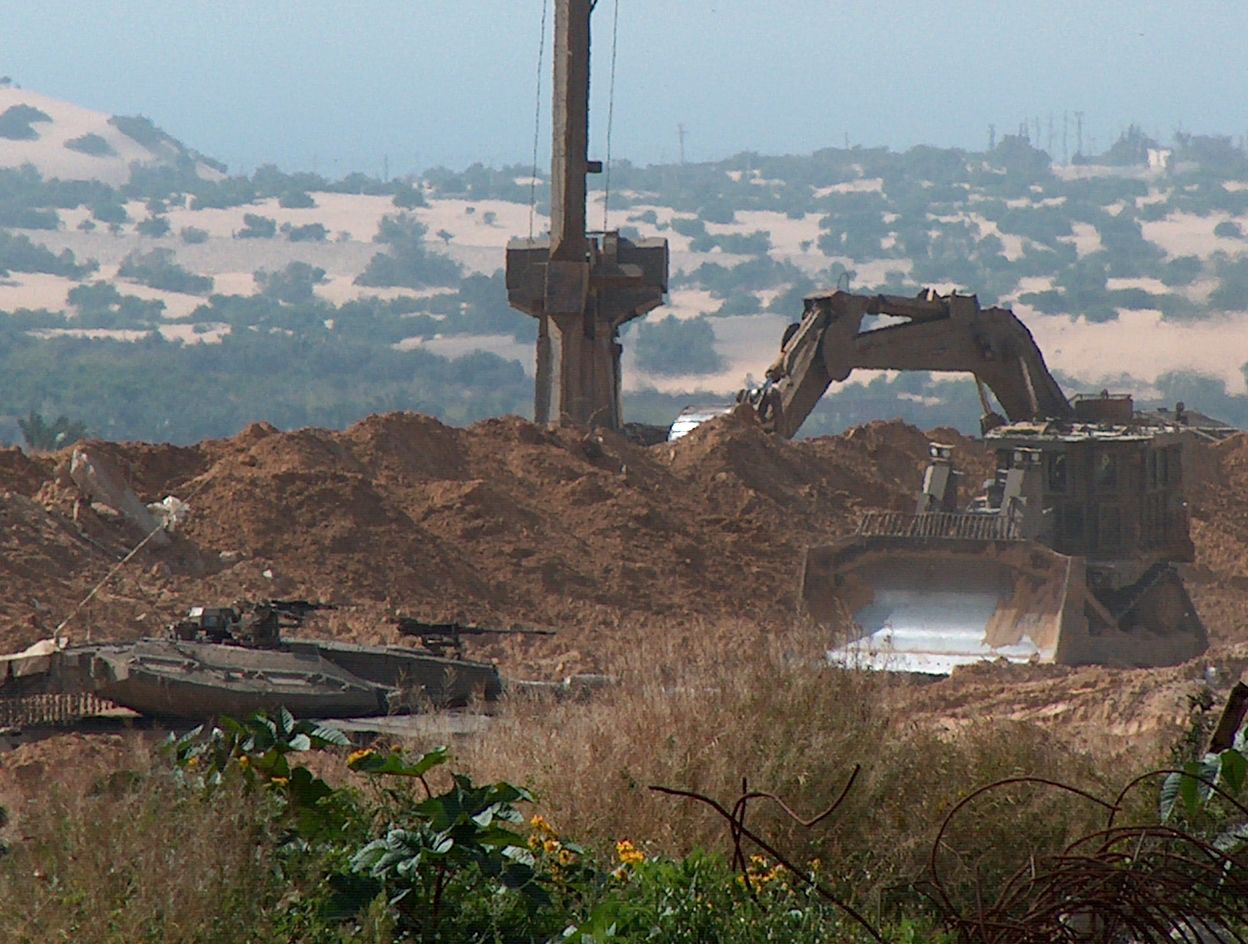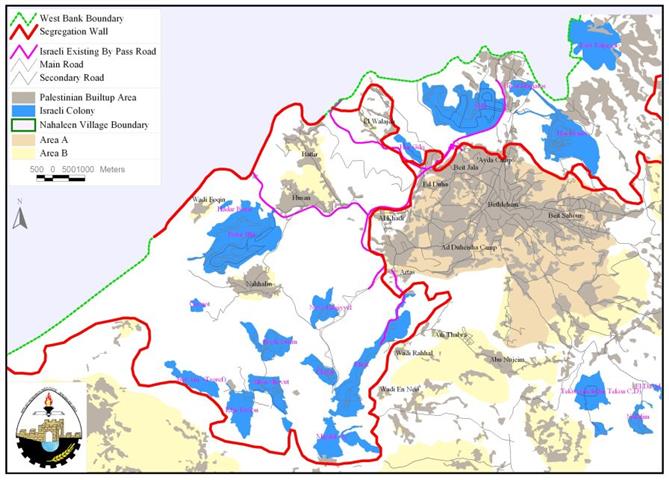On April 4, 2005, it was published in Haaretz daily newspaper that Israel has decided to transfer garbage beyond the Armistice Line (Green Line) and dump it in the West Bank. The dump operators plan to deposit some 10,000 tons of garbage from the Dan and Sharon regions every month in what is known as the Abu Shusha quarry, the largest in the West Bank. Haaretz mentioned that in the last few days, Israeli trucks and bulldozers have been covering the quarry's floor with brown soil to turn it into a garbage dump. Huge semi-trailer trucks are to bring the Sharon and Dan garbage, which will be amassed at the Hadarim garbage station near Tel Mond prison, to the quarry. See map of the new dumping site. (Green Line) and dump it in the West Bank. The dump operators plan to deposit some 10,000 tons of garbage from the Dan and Sharon regions every month in what is known as the Abu Shusha quarry, the largest in the West Bank. Haaretz mentioned that in the last few days, Israeli trucks and bulldozers have been covering the quarry's floor with brown soil to turn it into a garbage dump. Huge semi-trailer trucks are to bring the Sharon and Dan garbage, which will be amassed at the Hadarim garbage station near Tel Mond prison, to the quarry.
Israel's construction and operation of this dump is violating the international law which prohibits an occupying state from making use of occupied territory unless it benefits the local people. Besides, Article 55 of Geneva Conventions states concerning the Protection of the Natural Environment:
1. Care shall be taken in warfare to protect the natural environment against widespread, long-term and severe damage. This protection includes a prohibition of the use of methods or means of warfare which are intended or may be expected to cause such damage to the natural environment and thereby to prejudice the health or survival of the population.
2. Attacks against the natural environment by way of reprisals are prohibited.
During the past three decades, the Israeli occupation has been deteriorating the environment and natural resources in the Occupied Palestinian Territories. Beside direct pollution imposed by the activities carried out by the Israeli occupation, the Israelis are restricting plans for establishing adequate dumping sites to serve the Palestinians; additionally, the recent closure of many landfills by the Israeli military authorities has complicated the problems of solid waste management in the West Bank. ARIJ estimates that the Palestinians in the West Bank produce 500 thousand tons of solid waste yearly which means about 1370 tons daily. On the other hand, the Israeli settlements produce an average of 224 thousand tons yearly or 614 tons daily.
ARIJ would like to emphasize that water resources in the vicinity of the proposed dumping site will be jeopardized; Four wells that serve the city of Nablus and nearby villages such as Deir Sharaf and Beit Iba are located very proximate to the dumping site. The following Table introduces facts about these wells:
Table 1: Water wells located close to the new dumping site.
|
Well Name |
Abstraction (m3/year) |
Well Use |
Water Quality |
Aquifer |
|
Deir Sharaf 2 |
785,000 |
Agricultural |
Very good to Excellent |
Upper Cenomanian |
|
Deir Sharaf 4 |
273,000 |
Domestic and Agricultural |
Very good to Excellent |
Upper Cenomanian |
|
Deir Sharaf 3A |
790,000 |
Domestic |
Very good to Excellent |
Upper Cenomanian |
|
Beit Iba |
982,000 |
Domestic |
Very good to Excellent |
Lower Cenomanian |
The very high risk of pollution is mostly based on the fact that the proposed dumping site is located at the outcrop of the Upper Cenomanian formation; which holds the groundwater flow of Deir Sharaf 2, 4 and 3A wells. These wells are approximately 500 meters away from the dumping site; as a result, they are very susceptible to immidiate pollution from solid waste dumped in the nearby site. Taking into consideration that water quality in these wells is very good to excellent bringing up bad anticipations about the future of the water quality in these wells.
As the whole picture depicts, the proposed dumping site will endanger the wells located around the site, particularly those at the same formation. It will also present a great risk upon the environment, landscape and land use in the area and finally it will jeopardize the water quality of the Mountain Aquifer as a whole, which is one of the largest freshwater sources in Palestine and Israel. Other general consequences of operating the proposed dumping site will include the decrease of the surface area of lands owing to their use as dumps for solid waste disposal, the inconvenience caused to people due to the unpleasant smells and the spread of insects that gather on these solid wastes as well as the emitted smoke from the burning of such wastes and finally disfiguring the landscapes in that area.
We call upon the attention of the national and international communities to address this problem and work with ARIJ to stop the Israeli violations against the Palestinian Land / Environment and natural resources.
Prepared by:
The Applied Research Institute – Jerusalem














